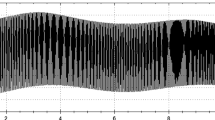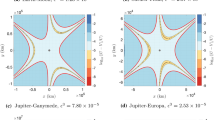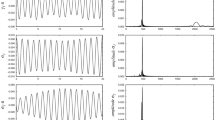Abstract
The numerical long-term prediction of the satellite motion is very laborious. This is mainly because the high rate of the change of the right member functions of the classical equation of motion results in a small step in numerical integration and, in turn, in a rapid accumulation of the round-off errors. As is well known, the application of regularizing and stabilizing variables allows avoiding these difficulties. The authors have constructed the numerical model of the motion of Martian satellites using the equation of motion written in rectangular coordinates (x),in regularizing and stabilizing Kustaanheimo—Stiefel (KS) variables (u) and in increments of KS-coordinates (δu).
Access this chapter
Tax calculation will be finalised at checkout
Purchases are for personal use only
Similar content being viewed by others
References
Bordovitsyna, T. V., Bykova, L. E. and Avdyushev, V. A.: 1998, ‘Problems in Applications of Regularizing and Stabilizing KS-transformations tosks of Dynamics of Planets’ Natural Satellites and Asteroids’, Astronom and Geodezy, 16, Tomsk, 33–57.
Chapront-Touze’, M.: 1990, ‘Orbits of Martial Satellites from ESAPHO and ESADE theories’, Astron. Astrophys., 240, 159–172.
Krasinsky, G. A. and Vasilyev, M. V.: 1996, ‘ERA: Knowledge Base for Ephemeris and Dynamical Astronomy’, In Proceeding of IAU Coloquium 165 “Dynamics and Astrometry of Natural and Artificial Celestial Bodies”, Kluwer Acad. Publ., 239–244.
Author information
Authors and Affiliations
Editor information
Editors and Affiliations
Rights and permissions
Copyright information
© 2001 Springer Science+Business Media Dordrecht
About this paper
Cite this paper
Titarenko, E., Bordovitsyna, T., Avdyushev, V. (2001). Numerical Simulation of the Motion of Martian Satellites. In: Pretka-Ziomek, H., Wnuk, E., Seidelmann, P.K., Richardson, D.L. (eds) Dynamics of Natural and Artificial Celestial Bodies. Springer, Dordrecht. https://doi.org/10.1007/978-94-017-1327-6_28
Download citation
DOI: https://doi.org/10.1007/978-94-017-1327-6_28
Publisher Name: Springer, Dordrecht
Print ISBN: 978-90-481-5865-2
Online ISBN: 978-94-017-1327-6
eBook Packages: Springer Book Archive




